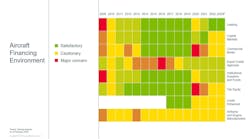Oct. 01 -- "Today is Day 1 of being shipwrecked," a survival trainer told a group of pilots and aviation professionals at the pool at the Hyatt Regency hotel Monday afternoon.
Before climbing into a bright yellow emergency raft in the pool, Aircare Solutions Group emergency egress trainer Mico Renee went through all the items found in the raft's survival kit, showing how and when to use them.
There are a number of procedures to follow after getting inside an emergency raft.
Count heads, cut the raft away from a sinking aircraft, organize the survival kit, assign jobs, treat the wounded and adopt a survival attitude, Renee said.
"You want to keep your spirits about you," she said. An aircraft emergency is a high-stress situation, and decisions must be made.
The training was part of a series of workshops and seminars offered at Bombardier's 17th annual Safety Standdown.
The four-day seminar has drawn 475 pilots, flight crew members, maintenance personnel and managers to Wichita. It includes attendees from Fortune 500 companies, from every branch of the military, from other manufacturers and from government agencies. Personnel from 297 companies are attending.
"It's a corporate social responsibility piece for us," said Bombardier spokesman Patrick Botter. "Bombardier wants to be at the forefront of safety and not just in manufacturing our products."
While an aircraft accident is unlikely, it's better to train for situations when there is not an emergency, the trainers said.
Renee, who was in the military and was a flight attendant on planes used by vice presidents and dignitaries, gave tips on the use of an emergency locator transmitter, paddles, signaling mirror, flares, SOS banner, fishing line, food rations and other items.
In a shipwreck situation, food, water, flashlight power and other items must be rationed, she said, because you don't know how long it will take for someone to rescue you.
John Slaybaugh is a pilot and safety officer for the flight department of Biomet, a medical device manufacturer based in Warsaw, Ind.
"I'm going to learn anything that has to do with safety and new techniques I can take back," Slaybaugh said. "A lot of this training you just don't find anywhere else. We changed a lot of our procedures in our flight department based on what we learned here."
Biomet operates two Cessna Citation XLS business jets. Nine of the flight department's 10 people have gone through Safety Standdown at various times.
On Monday, a group of 10 climbed into the raft in the Hyatt's pool.
Later, participants took turns in Underwater Egress Training, in which they were strapped into an aircraft fuselagelike structure in an airplane-style seat belt. Then they were turned upside-down in the pool and were trapped underwater.
They needed to unbuckle their seat belts and escape through a hinged window.
On Monday, participants also practiced how to respond to an onboard fire, how to recognize hypoxia and how to handle other emergencies.
It's good training, said Martin Hamilton, vice president of business development for Aircare Solutions Group.
People react differently to crisis situations: Some shut down physically, while others get hyperactive and can't concentrate. It can be hard to focus and act constructively. Training helps.
"You learn by doing, and you learn to control your stress," Hamilton said.
Other seminars will focus on such issues as safety management, human factors, leadership, crew monitoring, risk mitigation and managing fatigue.
Reach Molly McMillin at 316-269-6708 or [email protected]. Follow her on Twitter: @mmcmillin.
Copyright 2013 - The Wichita Eagle

